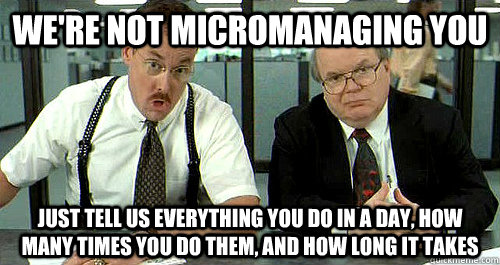Micromanagement is a demoralizing, controlling, rarely effective management method that wreaks havoc in many workplaces. While the intent behind micromanagement is often sincere, the resulting outcome leads to diminished productivity and employee morale. So, how can we learn the signs of micromanagement and how to prevent it? Let’s dive in.

What Is Micromanagement?
Micromanagement, in a nutshell, occurs when managers attempt to control project outcomes by excessively monitoring their subordinates. Micromanagement is sometimes useful on smaller projects, but it doesn’t yield healthy long-term results. Does your manager constantly hover over you or ask for repeated check-ins? Do you lack autonomy to make decisions? Does your manager assign you a task, but then completes it himself? Then you are likely working for a micromanager.
Micromanagement is prevalent for several reasons. The first is that managers do not want to lose touch. As managers are promoted, they tend to feel disconnected from the frontlines. To combat the disconnection, they engage subordinates to get direct feedback. Secondly, managers can be short-sighted. Correcting a subordinate takes twice as long as a manager completing the task without subordinate involvement. This short-term view results in managers missing deadlines and producing subpar work. New managers also often have difficulty letting go of old responsibilities, which results in micromanagement.
[optin-monster slug="oa6kdflxsmp4bi4azzgi" followrules="true"]
Signs Of Micromanagement
How can you recognize the signs of micromanagement? Micromanagers either do not delegate tasks or they neglect to give employees the necessary autonomy to complete tasks. In addition, many micromanagers do not trust their employees and often display this is in how they manage. The managers would rather do the work themselves than coach others. Micromanagement frequently leads to missed deadlines because managers are overextended. These are some of the more common signs of micromanagement.
Negative Effects Of Micromanagement: The Manager’s Perspective
Managers who try to monitor and control their employees often experience burnout. Because they focus on the details, they often neglect the company’s long-term vision, which impedes growth. Managers who try to do it all are building an organization that is not scalable. 70% percent of employees consider quitting when micromanaged, and 30% follow through and quit. High employee turnover increases costs, lowers morale, and erodes productivity.
Negative Effects Of Micromanagement: The Employee’s Perspective
Some of the negative effects of micromanagement are employees feeling undervalued, which leads to diminished productivity. Managers must build confidence and allow autonomy, or employees end up feeling demoralized. Hiring smart employees without allowing them space to test new ideas stymies creativity and reduces trust. Without trust, employees do not fully tap into their potential, and thus, don’t perform to the highest level.
A Little Levity - Micromanagement Memes
A few micromanagement memes may add some levity to an otherwise unpleasant topic. As depicted in these micromanagement memes, micromanagers ultimately kill trust and productivity because of their actions. It’s critical for managers to prove to their team members that they trust them. Without a foundation of trust, the chance for a team to achieve long-term success is low.

In a nutshell, you'll never get the best out of your team when you micromanage them.

It's a waste of time!

Oftentimes, employees will experience their micromanaging leaders as passive-aggressive. It gives them an overall negative feeling.

How exhausting! Micromanagers will chase good employees right out the door, costly companies money to find and onboard a new employee.
How To Prevent Micromanagement
If you’re wondering how to prevent micromanagement, we’ve got a few tips. First, give your team autonomy on smaller projects. Document the team’s performance and make sure to provide adequate support without controlling or requiring frequent reporting. Upon project completion, perform a review to identify areas of improvement. Give your team permission to be fully transparent. Document any discoveries so that similar mistakes can be avoided in future projects. Acting on each of these steps will help prevent micromanagement and establish trust.
As a manager, you must identify where your strengths/skills are most needed, prioritize projects/tasks that utilize those areas, and delegate other projects/tasks to competent people who have been hired to help you meet organizational goals. Regardless of your strengths, you will have to realize that you were not hired to do your subordinate’s job. Great managers leverage the strengths of their employees and focus on the bigger picture. This is how great managers provide the most value to their organizations.
What To Do If You’re Under A Micromanager?
If you are under a micromanager, open communication is imperative. Explain to your manager how autonomy increases your productivity and creativity. Try to understand where your manager is coming from and anticipate what they are seeking. Ask for a small project to prove your capability and establish trust. As you complete more projects with less supervision, your manager should grow to trust you and only offer support when needed. Utilize a digital progress report (like Jira) may minimize micromanagement and satiate your manager’s need to know your every move.
Conclusion
Micromanagement is rarely about controlling people - it’s about controlling outcomes. Unfortunately, micromanagement is rarely effective. It negatively affects productivity and employee morale. With increased awareness and training, managers can learn to let go of the need to micromanage, and employees can learn how to openly communicate with their managers to prevent micromanagement.
Additional Reading:
- Promote Job Openings to MC's >1M-strong community
- Top 6 Leadership Skills for Managers
- Leader vs Manager: A Difference of Purpose
- Mental Models: What Are They?
- Top Corporate Training Topics